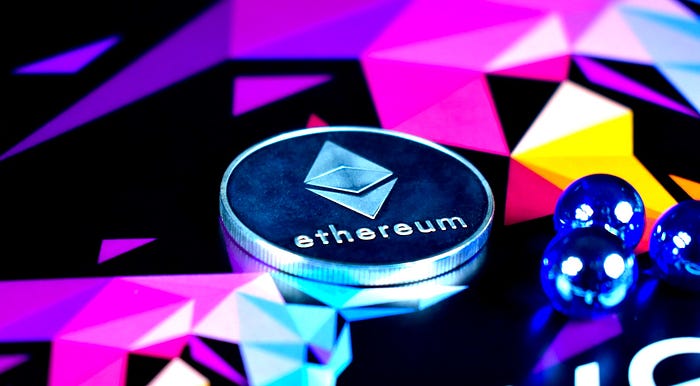Here’s a simplified explanation for normal people who don’t work in finance or aren’t technical.

Ethereum is cool. The problem is it’s incredibly complex.
I got involved with Ethereum in 2016. It’s one of the best decisions I’ve ever made. It has not only made me a tidy profit, but it’s given me a huge edge in my career. Being able to explain Ethereum in simple terms is a superpower. I want you to have that power in your hands so you can do good with it.
Bitcoin is easy to understand: slow-moving digital gold. When people say Bitcoin is a currency or it’s not used to make purchases, they show they don’t understand it. Bitcoin is a long-term savings account protected from inflation using code, thanks to scarcity (there are only 21M bitcoins). That’s it.
Ethereum is a lot harder to understand. It has hundreds of use cases. This is why if you start to learn about Ethereum and what it does, you can do well out of it. Every day I learn something new about Ethereum. It’s a beast.
Why should you pay attention to Ethereum?
- It’s the second-largest cryptocurrency. It launched in 2015.
- The network effects of Ethereum are impressive. Network effects helped the previous generation of tech companies make a lot of money. The next generation of tech will be blockchain-enabled, decentralized technologies such as Ethereum.
Some experts even say Ethereum will surpass Bitcoin in both size and price. This is why you need to pay attention to Ethereum.
What Is Ethereum?
– Ethereum is a world computer platform for decentralized applications.
– Ethereum is becoming more of a transaction and settlement layer.
– Ethereum introduced programmable money through smart contracts.
– Vincent Tabora
These are the three things Ethereum is known for. It can do a lot. Many cryptocurrencies are built on Ethereum, further increasing its usefulness and value. Ethereum helped enable Defi (decentralized finance).
Defi is easy to understand too. Defi takes every existing finance product we already use and removes middlemen, thus removing cost.
Trust on the internet is broken.
Ethereum is a way to fix ownership and use code to verify trust, rather than people who profit from taking advantage of the current trust system.
Imagine a world where banks, stock exchanges, credit card companies (Visa, Mastercard, Amex) are displaced. That’s what Ethereum is already beginning to enable, slowly. The problem of trust is a bigger problem than storing value and protecting it from inflation. This is why Ethereum has the potential to be worth a lot more than Bitcoin in the long-term.
Here’s the One Sign That Determines Whether the Ethereum Price Goes Beyond Bitcoin
Raoul Pal is a finance legend. He recently went from putting most of his money into Bitcoin to placing some of his money in Ethereum.
Raoul came up with a simple way to measure the potential future price of Bitcoin and Ethereum. Both cryptocurrencies have a concept known as addresses. An address is like a user’s account.
Raoul has shown that as the number of user accounts goes up — just like with Facebook, Twitter, Uber, Netflix, etc. — the price per coin and the total value of the network go up too. (I said network because Ethereum and Bitcoin aren’t companies — another cool feature of both technologies. Ethereum is built by thousands of developers all around the world that have dedicated their time to the project and combined their resources.)
This phenomenon is known as Metcalfe’s Law. The finance world has used Metcalfe’s Law for many years. All you need to know is the law helps explain how a network grows, and it helps you value a network such as Ethereum, without being a child genius.
Ethereum 2.0 Enlarges the Opportunity
Ethereum was already exciting. Then the Ethereum developers decided to announce Ethereum 2.0. This change isn’t easy to understand, especially if you don’t work in technology.
Essentially, Ethereum 2.0 makes it more like Bitcoin. This should blow your mind. Bitcoin is amazing because it’s scarce and deflationary. Ethereum 2.0 introduces the following:
1. ‘Staking’ (in dead simple terms)
Anybody can validate Ethereum transactions. Most of you reading this story won’t do that. Transactions need to be validated by the Ethereum network to create trust. By creating trust using the Ethereum Network, you don’t need middlemen to create trust.
The old way to validate Ethereum transactions was called ‘proof of work.’ Computers owned by humans would solve mathematical problems and burn up electricity in the process (similar to how Bitcoin works). With climate change being a hot topic, burning electricity is seen as a bad thing.
With staking all you need to do if you want to validate transactions is deposit and lock up 32 Ethereum coins. When you help to validate Ethereum transactions you earn Ethereum. Why does this matter?
Staking means those who validate and protect the network have to have skin in the game to do so. Skin in the game makes the people who connect to the network, and the network itself, more valuable.
Staking means there will be less Ethereum available, too, because some of the supply will be locked up by those who choose to stake. Less Ethereum means more scarcity. Scarcity is a feature that has made Bitcoin incredibly valuable. It can have a similar affect on Ethereum over time.
2. ‘Sharding’ (an easy explanation)
Sharding is coming on Ethereum 2.0. All it means for us normal folk is the Ethereum network is going to be split up into eighteen smaller parts. This will help to make the network faster. Sharding will allow the network to process more transactions per second.
A faster Ethereum network increases its value further.
3. The magic of ‘Token Burn’ on the price of Ethereum
Transaction fees on Ethereum have been high in recent times. Ethereum 2.0 makes a fundamental shift. Previously, those who validated transactions could set the transaction fee price. This enabled greed and overcharging.
With Ethereum 2.0, the price to validate a transaction is set by the network and adjusts based on the level of network activity. This change stops the greedy buggers from taking advantage of us normal people.
Pay careful attention to the next part. This update also enables token burn. Token burn is where a percentage of the transaction fee paid to those who validate the network is burned. This decreases the overall supply of Ethereum over time, further enabling glorious Bitcoin-like scarcity.
In simple terms: the supply of Ethereum coins decreases as the network usage increases. Read that again.
This means as Ethereum is adopted more and more, the number of Ethereum will decrease. When the number of Ethereum decreases, and demand increases, the price per Ethereum goes up.
Token burn is deflationary, the opposite of inflation. The value of the US dollar is decreasing over time because more dollars are being created out of thin air. Ethereum is programmed to be deflationary — meaning the value is going up not down like US dollars.
Summary of Ethereum 2.0 for normal people:
- Faster.
- Cheaper Ethereum transactions.
- More secure.
- Able to host more use cases for technology solutions (apps/software) that require the problem of trust to be solved (please someone fix social media).
- Easier to understand and use.
- Skin in the game for those who choose to validate Ethereum transactions.
- A better way for people to earn money from building and working on Ethereum.
- Big Change: Ethereum becomes scarcer over time.
Should You Invest in Ethereum?
Only you can answer this question based on your situation. Stocks feel wrong to me right now. I don’t like buying at the highest prices in history. So I definitely have and will buy more Ethereum. I apply the 80/20 rule to Bitcoin and Ethereum. If I invest $1000 then $800 goes into Bitcoin and $200 goes into Ethereum.
There is no doubt Ethereum is going to play a huge role in our lives. I think it’s worth a small investment, but only if you have money you’re prepared to risk.
Ethereum Is Quietly Changing the World
The current version of the internet is broken. It is centralized and open to manipulation, as we’ve seen over the last two years with companies like Facebook abusing our trust.
The future of the internet won’t be owned by a few big tech companies — the future of the internet is going to be owned by the users again. Users will own their data and their destiny.
Web 2.0 was a read and write platform.
Web 3.0 is a read, write, and own platform.
Ethereum enables Web 3.0 and that’s why it has value and will be the next big mover after Bitcoin. Ethereum has the potential to become the plumbing for every app ever built in the future.
In the war against early search engines, Google was the quiet sleeper. In the war against rebuilding traditional finance, Ethereum is looking like the quiet sleeper. Bitcoin was a big idea that fixed the store of value problem and gave rise to digital gold.
Bitcoin is 12 years old. Ethereum is 5.5 years old. Ethereum still has a long way to go and is just getting started. Bitcoin is big. Ethereum’s potential is bigger. Let me give you the reason in one sentence:
Ethereum has the power to reinvent the global financial system, become the platform all future decentralized apps are built on, and to fix ownership once and for all.
Those three reasons are what makes Ethereum the quiet sleeper, and the next big mover after Bitcoin. Ethereum 2.0 is going to make Ethereum scarcer and bring simplified new features that will mimic some of the positives of Bitcoin.
You can benefit from the Ethereum revolution by doing your own research and being incredibly patient. The future is being built on Ethereum right in front of you. Dare to pay attention.
